13 Proteins You Probably Never Thought To Pair With Pasta
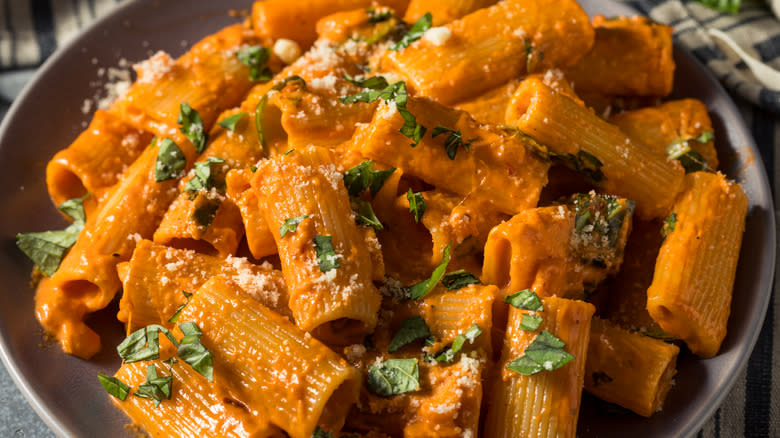
In kitchens everywhere, pasta stands as a reliable staple, ready to blend with both familiar and unusual flavors. We encourage you to venture slightly beyond the typical flavor combinations and explore pasta dishes with some unexpected yet appetizing protein alternatives. Using versatile ingredients like century eggs, frog legs, pig ears, chicken feet, and crickets, there's plenty of potential to create some unique masterpieces in your kitchen.
Trying out ingredients like these can do more than simply inspire new recipes — it can provide some thought-provoking experiences and hopefully initiate intriguing conversations at your dining table. Exploring the realms of traditional and contemporary cuisines, the introduction of unconventional proteins offers not only fresh culinary possibilities but also a glimpse into food history and culture-rich culinary narratives. Incorporating these elements into your pasta dishes could be a journey that goes beyond creativity, fostering a deeper appreciation for the diverse global cuisines that can merge seamlessly with the familiarity of pasta.
Read more: 12 Unique Pasta Shapes You Need To Start Experimenting With
Crickets
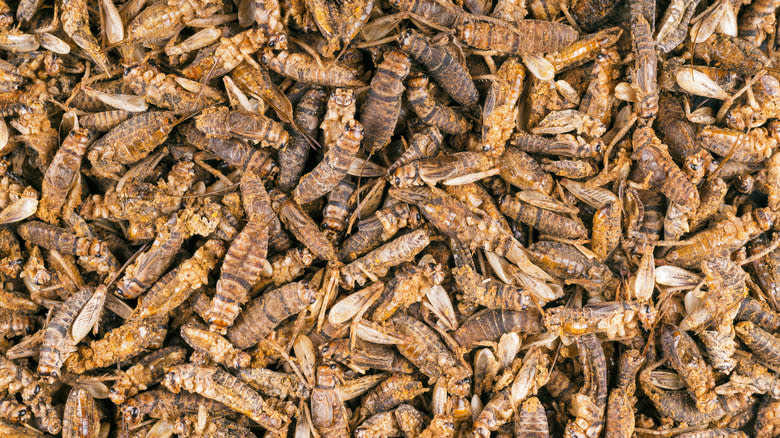
Crickets are increasingly recognized as an environmentally friendly and nutritious protein source. They're an exceptionally sustainable protein option, requiring minimal resources compared to traditional livestock. Additionally, they're a nutritional powerhouse, boasting high protein content, fiber, essential vitamins, and minerals. To begin incorporating them into a pasta dish, consider options like the readily available cricket powder or pre-packaged roasted crickets, which can be effortlessly sprinkled over or mixed into your pasta sauce. Cooking with crickets can give the dish a rich umami flavor with a subtle nutty undertone.
For an effective pairing, consider crafting a sauce that features complementary flavors. A garlic-infused olive oil can serve as a straightforward yet flavorful base. Adding a smattering of fresh herbs like rosemary or thyme can subtly enhance the dish, adding layers of flavor without overwhelming the taste of the crickets. Given the inherently nutty flavor profile of crickets, a light sprinkle of toasted nuts or seeds, like pine nuts or pumpkin seeds, can taste good while also offering a nice texture contrast.
Tempeh

Tempeh, a traditional Indonesian food, is made from fermented soybeans and has a rich, nutty flavor. A potent source of plant-based protein, it also boasts high levels of fiber and a variety of essential vitamins and minerals, helping to contribute to a balanced diet. Its fermentation process not only makes the nutrients more digestible but also produces probiotics, which are beneficial for gut health. Incorporating tempeh into a pasta dish is quite easy — it can be crumbled or sliced into small pieces and sautéed to give it a golden, crispy exterior. When considering the type of pasta to pair with, opt for robust shapes like penne or fusilli, which can hold up to the substance of the tempeh.
Tempeh also plays well with seasonings like garlic powder, smoked paprika, and a touch of cayenne for a hint of heat. An excellent source of vegetable protein, it can seamlessly replace traditional meats. Whether tossed with a rustic marinara sauce over spaghetti or incorporated into a creamy Alfredo with fettuccine, some seasoned, pan-fried tempeh brings a refreshing twist to classic pasta preparations.
Bison
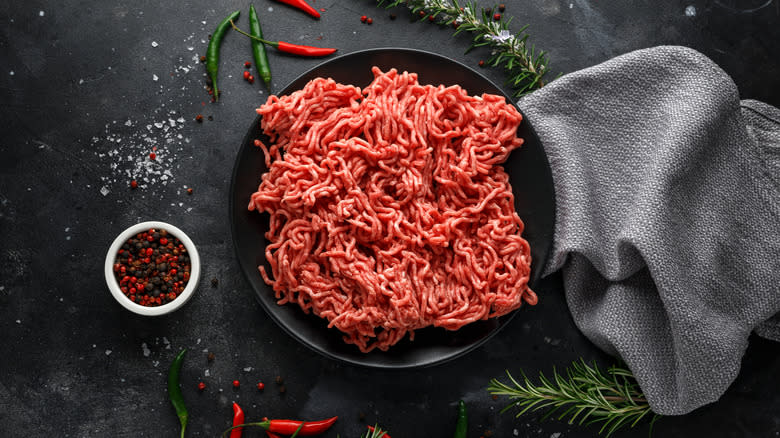
Bison is a lean yet flavorful alternative to traditional meats, particularly beef. Ground bison is carving a niche for itself in contemporary cuisine, prized for its slightly sweet taste and rich nutrient density, being a great source of omega-3 fatty acids, iron, zinc, selenium, and vitamin B12. A versatile option for pasta dishes, it works excellently in preparations such as a hearty Bolognese sauce. Here, the ground bison combines seamlessly with tomatoes and herbs, giving a rich and nuanced flavor that goes beautifully in a pasta dish. Thinly sliced bison steak can also be a stellar choice, quickly seared and tossed with a fettuccine alfredo or a pepperoncini pasta, introducing a slightly different texture and flavor dynamic to the dish.
What's more, ground bison is an excellent base for meatballs, offering a tasty combination when served with spaghetti or linguine. To enhance its natural flavors, a seasoning blend incorporating garlic, onion, and a touch of rosemary works wonders. If you are looking to experiment with sauces, a tangy marinara or a rustic puttanesca sauce could serve as vibrant options, balancing the sweetness of the bison with a touch of acidity.
Seaweed
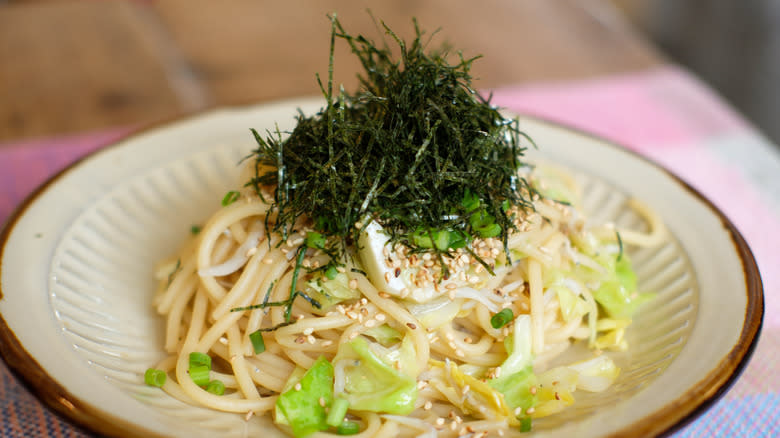
Often overlooked as a protein source, seaweed is steadily gaining recognition. Actually an entire class of sea vegetables, seaweed is not only a rich source of minerals and vitamins but also boasts a substantial amount of protein, making it a nutritious alternative to meat. Diverse varieties of kelp such as nori and wakame, often used in Japanese cuisine, offer a range of flavors and textures that bring a hint of the ocean's brininess to your pasta dish.
For a fresh, summer-inspired dish, consider tossing thin strands of spaghetti with a seaweed pesto, made by blending seaweed with garlic, nuts, and a splash of lemon juice, to give a zesty and umami-packed dimension. Alternatively, for a warm, comforting meal, a seaweed-infused cream sauce paired with fettuccine can treat your palate to smooth and savory umami-rich flavors.
Pasta made with mentaiko, a spicy cod roe also enjoyed in Japan, can serve as an excellent blueprint for those who want to experiment with seaweed as a pasta ingredient. It's typically garnished with copious amounts of sea vegetables, complementing the spicy flavor that forms the base of the sauce. Moreover, shredded nori or wakame can be directly integrated into the dish, using them as the main protein source in an innovative take on a classic aglio olio.
Tofu

A cousin of tempeh, tofu is another popular soy-based food that's rich in protein and all nine essential amino acids, helping it carve out a niche as a healthful alternative to traditional meat-based dishes. This adaptable ingredient, largely neutral in taste, effortlessly takes on the flavors and spices it is paired with. Firm tofu can give a meaty consistency to Bolognese sauces, while silken tofu can introduce a creamy element to Alfredo and carbonara preparations, working well as a healthier substitute for heavy creams.
Fusing East with West opens up new possibilities. Consider a dish that unites the crispy yet tender agedashi tofu with the light and fine strands of angel hair pasta, lightly tossed in a soy-based sauce infused with fresh herbs. Taking a page from Thai cuisine, you can also create a dish that integrates the sweet and sour flavors of tofu pad thai, stir-fried with the nutty taste of whole-wheat spaghetti instead of the usual rice noodles. For those who appreciate a touch of heat, consider serving mapo tofu on a bed of tagliatelle instead of rice.
Fish Maw

Fish maw, widely considered a delicacy in Chinese cuisine, is essentially the swim bladder of a fish — an organ that aids in maintaining buoyancy. This ingredient is known for its chewy, gelatinous texture, and is a rich source of protein, particularly collagen with a low level of fat, making it especially favored by Eastern diets focused on health and wellness. Traditionally, fish maw finds its place in soups, stews, and braised dishes, often making an appearance in festive meals and celebrations, in dishes symbolizing prosperity and good fortune.
Fish maw is a premium ingredient, usually available in Asian markets or online stores, where it's sold in a preserved, dried form. Before cooking, the dried fish maw needs to be rehydrated by soaking it in water until it reaches a jelly-like consistency. Due to its neutral flavor, it can integrate well with various sauces, meaning it can work well in pasta dishes. Fish maw can be stir-fried with vegetables and seasonings and then paired with pasta like linguine. Additionally, it complements creamy sauces like carbonara or Alfredo well. Its versatility not only allows but encourages culinary exploration, offering a new dimension to familiar pasta recipes.
Sea Cucumber

Despite its name, the sea cucumber is not a plant but a marine animal found abundantly in oceans worldwide, related to starfish and sea urchins. While it isn't a vegetable, it gets the name of "cucumber" from its elongated shape, resembling the familiar salad vegetable. It has a gelatinous texture with thicker skin, somewhat similar to very tender pork belly or braised beef tendon, offering a subtle crunch and a melt-in-the-mouth experience.
Sea cucumber is a staple in many Asian cuisines, particularly within Chinese culinary traditions where it's prized for its supposed health benefits, including high levels of collagen. It's often used in soups and stews, with a famed dish being braised sea cucumber, in which it beautifully absorbs the rich flavors of the accompanying ingredients. Sea cucumbers are usually sold dried in Asian markets or through specialized online stores, and need to be rehydrated and cleaned before they're ready to cook.
Used in fusion cuisine, sea cucumber can be sliced and simmered in a garlic-infused white wine sauce to be served with linguine or fettuccine. Alternatively, it can be included in a frutti di mare dish, together with ingredients like shrimp and scallops in a rich tomato-based sauce, laid atop a bed of spaghetti.
Pig's Blood
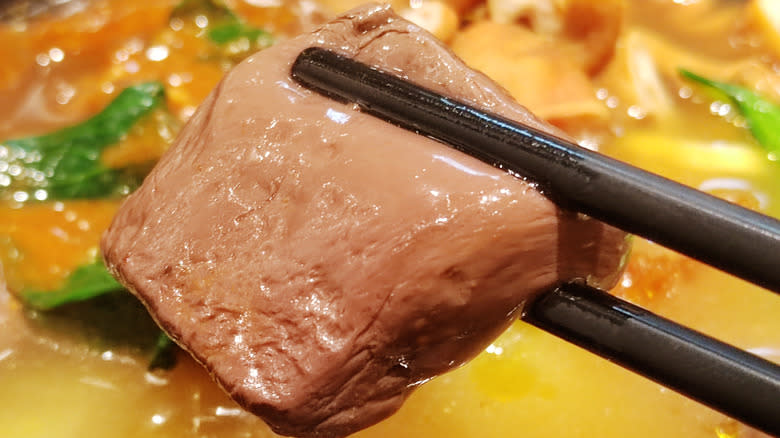
In the culinary world, pork blood is most commonly used in a solid form, deviating from the natural liquid form that might be expected. It's made through a coagulation process which yields a firm, jelly-like texture, somewhat reminiscent of a set custard. While similar to European dishes like blood sausage, its unique flavor and texture don't have a direct parallel with any mainstream Western meats. It has a rich taste, and could possibly be likened to a dense pâté.
In Eastern culinary traditions, pork blood serves as a staple in dishes such as pig's blood soup, a stew that often incorporates tofu and vegetables. Additionally, it shines in Taiwanese blood cake, a delicacy that blends pork blood with sticky rice, typically prepared through steaming or frying. This ingredient can generally be found sold by butcher shops, Asian grocery stores, or markets that specialize in offal.
When cooked with pasta, pork blood can be diced and used as a rich, unique protein. Given its umami-packed flavor, it would pair well with a hearty sauce like a thick, rustic tomato sauce or a rich, garlic-infused oil-based sauce. The ideal pasta to pair with this would be one designed to retain sauce, such as conchiglie, tagliatelle, or pappardelle.
Frog Legs
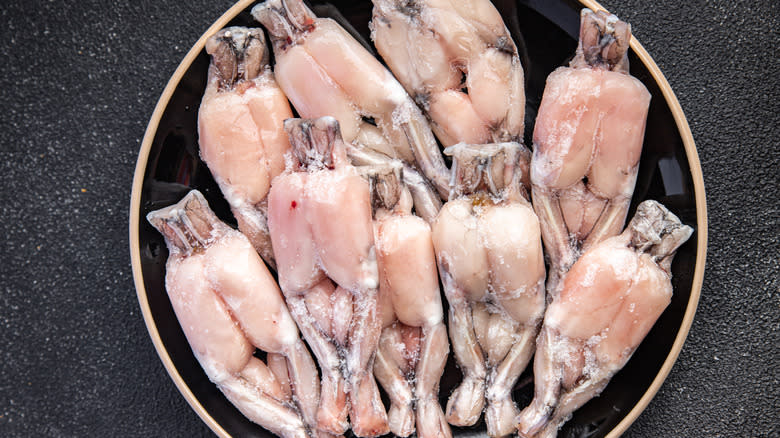
Renowned in both French and Asian cuisines, frog legs are cherished for their texture which resembles that of chicken, with a neutral flavor more akin to fish but without any strong aroma. In the United States, they have found a place in Southern gastronomy, notably in dishes such as frog leg étouffée. They are commonly found in specialty or online grocery stores, where they can be bought fresh or frozen. Suitable for grilling, frying, or stewing, frog legs are a versatile ingredient thanks to their inherent mildness, playing well with a wide spectrum of seasonings, from the simple duo of salt and pepper to the spicy tang of buffalo sauce.
To some, frog legs might be thought of as a unique protein addition to pasta, a deviation from more traditional choices. Nevertheless, an increasing number of frog leg pasta recipes are now circulating online, showcasing an excellent use of this protein. Examples include fried frog legs served over linguine with a hearty marinara sauce, a filling for ravioli, seared frog legs with garlic butter served with fettuccine, or sautéed frog legs with garlic, onions, tomatoes, and parsley served with spaghetti.
Century Eggs

Century eggs, despite their name, are not preserved for 100 years. Rather, they are a popular delicacy in Chinese cuisine, commonly made from duck eggs. Also known as pidan or 1,000-year eggs, they boast a distinctive appearance — a dark brown "egg white" the color of black tea and a creamy, dark yolk, which can seem quite unusual at first glance. This color change is a result of a preservation process wherein the eggs undergo alkaline fermentation in a mixture of clay, ash, salt, quicklime, and rice hulls over several weeks or months. In terms of texture, they have a unique, jelly-like consistency in the egg white, presenting a stark contrast to the firmness found in regular eggs. These culinary delights are primarily available in Asian markets or online, typically sold in packs of six or more.
The unique flavor of century eggs gives a prime opportunity for culinary fusion. Drawing inspiration from successful cross-cuisine dishes, particularly itameshi, century eggs can be paired with creamy sea urchin pasta, adding a layer of richness to the dish. Due to its similar flavor profile, it can offset pollock roe, making it an excellent addition to a mentaiko pasta recipe. Better yet, slice a cold century egg into several pieces and serve atop a cacio e pepe to level up its texture.
Pig Ears

Pig ears, often relegated to the category of lesser-used animal parts in Western gastronomy, are in fact a delicacy in several culinary traditions across the globe. In the Southern United States, they find their place in soul food, typically braised until tender. Chinese cuisine often showcases pig ears as a cold appetizer, marinated in a soy-based sauce with spices, presenting a combination of chewy and crunchy textures. Their taste and texture can be somewhat reminiscent of bacon, though significantly more cartilaginous, offering a crispy bite when prepared correctly.
In a pasta dish, pig ears can be thinly sliced and crisped to replace pancetta in an Amatriciana, providing a crunchy contrast to the soft pasta, or used as a topping on a spicy arrabbiata, lending a savory note to the tangy tomato sauce. If you are a culinary adventurer keen on practicality, visit your nearest Chinese grocery store to find pre-cooked, braised pork ear slices — usually found in the cold appetizer section next to deli meats. Try whipping up a spaghetti aglio olio with no meat, and garnish it with ear slices.
Chicken Feet
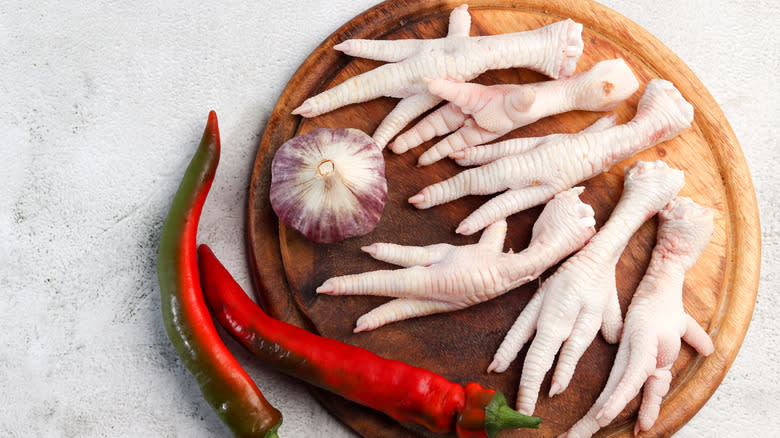
"Chicken feet" are precisely that — the feet of a chicken — and they hold a distinguished place in various dishes, notably in Chinese, Filipino, and South African cuisines. To the Western palate, the notion of eating chicken feet might evoke a certain level of unfamiliarity, primarily since this part of the chicken is not a staple. Their preparation often involves an initial blanching to remove the outer layer of skin, followed by a thorough cleaning before they're cooked in a variety of methods including stewing, frying, or grilling. The texture, a meld of gelatinous and slightly chewy, is uniquely delicious.
For those willing to try a straightforward culinary fusion, a visit to a nearby dim sum restaurant can be a good first step. Usually, these eateries have chicken feet prepared in a black bean sauce, known as "feng zhao" or "phoenix claw" as part of their menu — it's a Cantonese specialty, so you should find it at any good Hong Kong-style restaurant. Simply bring a portion home, cook a batch of plain spaghetti, and top it with the chicken feet along with the sauce. Allow the pasta to soak up the rich, deep flavors of the black bean sauce, that might just have you drooling in anticipation.
Tuna

Tuna, a warm-sea fish, is recognized globally for its substantial culinary use in both Eastern and Western cuisines. In Western dishes, tuna is often canned or served fresh in salads and poke bowls, appreciated for its firm, steak-like texture that grills well. Additionally, it's a significant source of essential nutrients such as proteins and omega-3 fatty acids that, according to WebMD, can lower the risk of cardiovascular diseases. In Japanese cuisine, tuna is esteemed, often found uncooked in premium sashimi and sushi dishes where the freshness and quality of the fish are paramount.
When it comes to pairing with pasta, a simple puttanesca sauce, with its tangy tomato base complemented by olives and capers, can accentuate the taste of the tuna. Alternatively, for a fresh take, consider a Sicilian-inspired tuna pasta featuring hints of capers and a medley of mixed-color cherry tomatoes. For a more adventurous fusion, consider trying slices of tuna sashimi served with soy sauce and wasabi atop a bed of cold spaghetti.
Read the original article on Daily Meal.

